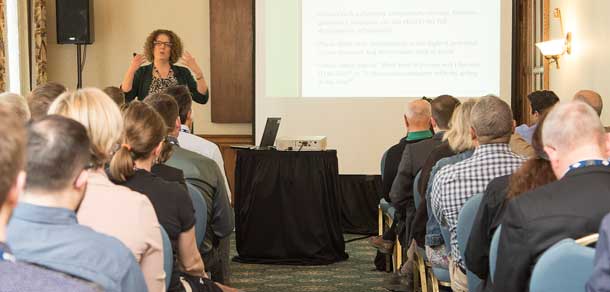Navigating conflicts of interest in the workplace
Along with having a certain standard in education and training, professionals have ethical and moral expectations. They have a responsibility both to their profession and to themselves to make the right decisions, but sometimes making the best moral decision isn’t always clear cut.
In Trish Harper’s presentation, “Conflicts of Interest in Your Professional Work” at the APEGS Annual Meeting, she outlined the different tactics people use when making moral judgments. Harper has a private practice in counselling and consulting and serves as an adjudicator for Social Services for the government of Saskatchewan.
Common approaches include:
Utilitarian
“What is the greatest good that will come from this decision that we’re going to make?”
Rights
“Will this decision respect and uphold the dignity and inherent worth of the other person?”
Fairness
“Does this decision treat everyone equally?”
Common good
“Does this action contribute to life in the community?”
Virtue
“What kind of person will I become if I do this? Is this action consistent with my acting at my best?”
“The common good and the virtue approach are the two I think about the most when making decisions,” she said. “You have to consider all those different layers as you make those decisions sometimes.”
To put it another way, “If this was made public, if the media got hold of this . . . what would happen? If this became public knowledge, would we still make that decision? How would it be perceived?” Or as one commentator suggested, “What would your mother say?”
In all of the examples discussed, disclosure and transparency were considered the best ways to avoid falling into a moral conundrum when it came to a conflict of interest, though Harper did note that workplaces with a poor culture will make these decisions more difficult.
“The culture and the relationship of you to your manager, to your team – the workplace culture really does change how we disclose information. Who are our mentors who help guide us and figure out how to navigate these situations”.
Conflicts of interest can easily arise when you work for more than one client. Other examples included leaving an organization to join a competitor or private work, or participating in a bidding selection where family is involved.
“We live in a province where there’s a lot of dual relationships, and we live in a province that is rural or remote, and you can’t help but have a relationship with a client in more than one way,” she said.
“We try to prevent conflicts of interest from happening, but sometimes they can pop up.”
When it comes to conflict of interest, though, perception is as important as reality. A perceived conflict of interest could be as damaging as a real conflict, leading to a loss of trust or an erosion of public confidence.
“Not only do people start to mistrust, but then they could potentially take their business elsewhere or increase the capacity for negative interaction with you because they don’t trust that what you’re doing is coming from a professional place but out of a place of interest . . . Loss of trust is extremely important to think about.”
